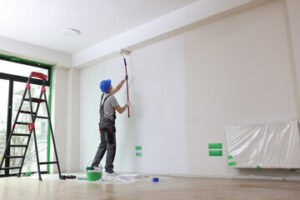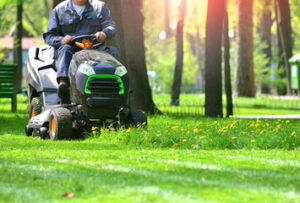Even the sturdiest roofs will eventually experience damage from wear and tear. This can manifest in the form of water stains on the ceiling or musty odors from mildew and mold.

Depending on the severity and scope of the damage, repairs may be an effective solution. However, if the damage extends across large sections of the roof, a complete restoration will be more beneficial long-term. Contact Roof Repair Near Me for professional help.
It can be a real horror show to walk into your attic and see water stains spreading across the ceilings and walls. Not only is this unsightly, but it can also threaten the structural integrity of your home, leading to costly repairs if not addressed promptly. When it comes to identifying water damage caused by roof leaks, a visual inspection of the affected area is critical. But, more than just spotting discolored spots on the walls and ceilings, homeowners need to evaluate adjacent areas for moisture-related damage, such as sagging wood or warped joists and beams.
When water seeps into the attic, it creates a moist environment that promotes mold growth and deteriorates insulation and wooden framing. Moisture can also cause drywall to swell, crack, or bubble, and it can lead to the formation of a musty or mildew-like odor in the home. This is often indicative of a roof leak that needs immediate attention.
Leaks from damaged shingles or roofing components are usually the first to show up in the attic, while non-roof related leaks can occur due to poor attic ventilation or plumbing leaks around ceiling fixtures like showers and recessed lighting. For this reason, homeowners should always examine the attic after a rain storm to identify leaks that might not be apparent from the interior of the home.
Check the attic for shingle ridge vents, chimneys, and skylights for signs of water penetration. Damaged or leaking flashing around these areas is another common source of leaks, and it is important to replace damaged or missing shingle caps, as well. Examine the gutters for clogs or leaks as well, as these can cause roof overflow and subsequent damage to the attic.
In addition to these obvious sources of water leaks, look for a white residue on the attic floor that may indicate the presence of “shiner” nails. These nails missed their framing members and can allow moisture to escape into the cold attic space, where it condenses as frost. These nail heads must be clipped with side-cutting pliers to prevent further water damage.
Check the Gutters
If you live in an area with heavy rainfall, you need to keep your gutters free from clogs and damage. Gutters are a vital component of your roof system because they direct excess water away from the roof and house siding. If they are clogged or damaged, the extra water could damage the foundation of your home and cause water leaks inside your living space.
Checking the condition of your gutters should be part of every roof inspection. If you notice any of the following signs, it is time to call for a professional gutter cleaning or repair.
Gutter Hangers Loose or Broken
If the gutters become overloaded with debris, they will start to sag and pull away from the roof eaves. This can lead to further damage and encourage plant growth that will clog the gutters even more. In addition, sagging gutters can be dangerous for anyone entering or leaving the home.
Look for rust spots and holes in the gutters. These can be a sign of serious wear and tear that require replacement. You should also check the downspouts for leaks and clogs. If you see a lot of shingle granules in the gutter, this is a sign that your asphalt shingles are beginning to deteriorate and need replacing.
Leaking Gutters
Water leaking from the gutters can infiltrate your living space and damage ceilings, walls, insulation, and wood trim. The water will also wash away the soil around your foundation, causing cracks and potentially damaging your home’s structure.
Another important thing to look for is a drip edge at the bottom of your fascia board. Without a drip edge, the fascia boards can begin to rot or even collapse. The drip edge helps to guide the water that drains from the gutters so it doesn’t come in contact with your fascia or house siding.
Lastly, you should check the areas around your home’s doors and windows for any water leaks or signs of moisture damage. If you have noticed any of these problems, you should call for a professional gutter repair or roof restoration.
Check the Shingles
The shingles are your roof’s first line of defense, and any deterioration or damage could leave your home vulnerable to water infiltration. Look for signs of damage such as cracks, curling, and blistering. If you see a significant number of missing shingles, it’s time to call for a professional.
If the shingles themselves are damaged, you’ll probably have to replace them as well. Missing shingles are most commonly the result of wind or hail storms that lift and tear them. A thorough inspection of the shingle area should also include checking the gutters and downspouts for any granules (which usually look like dark rubber balls or sand). If you find large clusters of these granules, they indicate that the asphalt shingles are deteriorating rapidly.
Another telltale sign of a problem with your roof is dark streaks on the ceiling and a musty smell in the attic. These may be caused by a leak, which is one of the most urgent reasons to call for a roof repair. Water infiltration will eventually cause rot, mold, mildew, and stains.
In addition to missing shingles, check for dark spots on the roof decking and attic floor, as well as sagging areas in the roof structure. These problems are best addressed by a qualified roofing contractor, but you should still take the time to inspect them for yourself and keep track of any areas that need attention.
Shingles that crack or chip are a more serious issue, since they expose the underlying roof to water penetration and UV damage. Cracks and chips are easy to repair, but if they continue to expand, the weakened shingle will need to be replaced.
If a shingle is simply cracked, you may be able to save it by applying a dab of roofing sealant under the corner and weighing it down with a brick for 24 hours while it dries. If the shingle is torn or completely detached, however, you’ll likely need a full replacement. In this case, it’s best to contact a roofing contractor to conduct an insurance claim and complete the necessary repairs.
Check the Flashing
One of the most common causes of roof leaks is flashing problems. The flashing is a thin strip of metal installed underneath shingles or other roofing materials around roof protrusions like chimneys, skylights, vents, and valleys. Its primary function is to prevent water from seeping into a home at these points where the roof intersects other parts of the structure.
Like other parts of a roof, the flashing can be damaged by extreme weather conditions, age, and poor installation. As a result, it is important to regularly inspect it for signs of leaks or other damage.
In addition to checking for rust or corrosion, you should also examine the flashing for loose or missing pieces. Loose flashing can leave gaps that allow water to penetrate a roof, leading to shingle loss, interior moisture, mold, and mildew. This is particularly true around chimneys, skylights, and other areas where the flashing must penetrate a wall or other part of a home.
If you notice loose or missing flashing, it is essential to contact a professional for a thorough inspection and repair. In many cases, a roofer can simply reseal the loose area with specialized roof sealant. However, more extensive damage to the flashing may require replacement.
Leaking roof flashing isn’t always easy to detect, especially if the leak is occurring under shingles or other roof material that can’t be seen from the ground or through a window. If you suspect that your flashing is leaking, send someone up in the attic with a garden hose and ask them to gently run the hose across the intersecting areas of your roof, like near chimneys, skylights, and vents. If the attic person can hear water dripping at a specific point, it is likely that the flashing in that area needs to be repaired or replaced.
Metal flashing, which is typically made from copper, aluminum, or steel, is susceptible to rust and corrosion. When rust appears, it is crucial to have the flashing professionally cleaned and protected in order to extend its lifespan. Ideally, this should be done during a regular roof inspection or at least after severe weather events.








